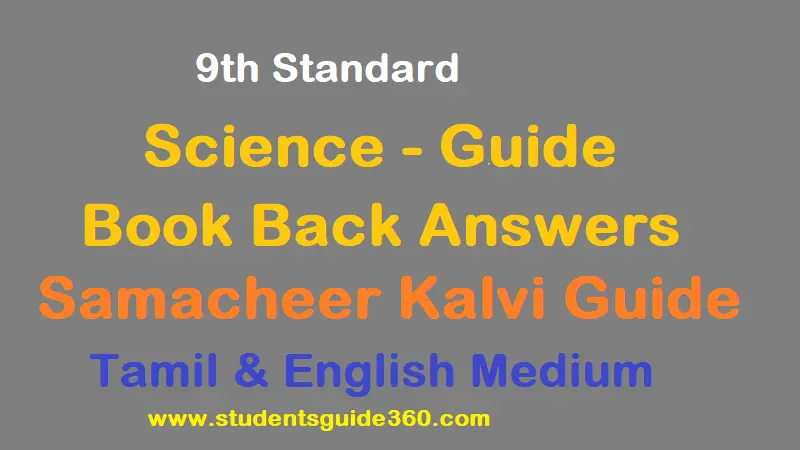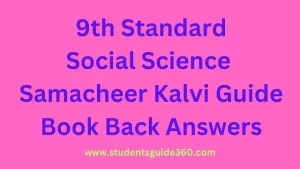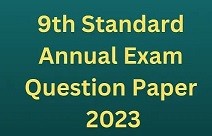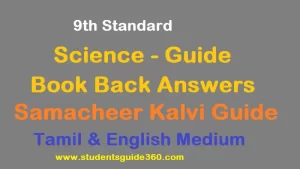9th Science Guide Unit 9 Universe
9th Science Lesson 9 Universe – English Medium
9th Science Book Back Answers Unit 9. 9th Science Lesson 9 Universe Book Back Answers. 9th Standard Science Samacheer kalvi Guide Book Back Answers download PDF Tamil Medium and English Medium book in answers. 9th All Subject Guide. Class 9 Science Questions and Answers. Class 1 to 12 All Subject Guide.

9th Science Lesson 9 Universe
I. Choose the correct answer:
1. Which of the following statements is correct?
- There are eight planets in our Solar System.
- Except Mars, all other planets revolve around the Sun in elliptical orbits
- A only
- B only
- Both A and B
- None
Ans : A only
2. Who proposed the heliocentric model of the universe?
- Tycho Brahe
- Nicolaus Copernicus
- Ptolemy
- Archimedes
Ans : Nicolaus Copernicus
3. Which of the following is not a part of outer solar system?
- Mercury
- Saturn
- Uranus
- Neptune
Ans : Mercury
4. Ceres is a _______.
- Meteor
- Star
- Planet
- Astroid
Ans : Astroid
5. The period of revolution of planet A around the Sun is 8 times that of planet B. How many times is the distance of planet A as great as that of planet B?
- 4
- 5
- 2
- 3
Ans : 2
6. The Big Bang occurred ________ years ago.
- 7 billion
- 15 million
- 15 billion
- 20 million
Ans : 13.7 billion
II. Fill in the blanks.
- The speed of Sun in km/s is _______. Ans : 250 km/s
- The rotational period of the Sun near its poles is ________. Ans : 36 days
- India’s first satellite is _______. Ans : Aryabhata
- The third law of Kepler is known as the Law of ________. Ans : Harmonies
- _______ is the only moon in the solar system that moves in the opposite direction to the direction in which its planet spins. Ans : Triton
- The number of planets in our Solar System is _______. Ans : 8
III. True or false.
- The distance between Saturn and Uranus is about 10 times as that between Earth and Mars. ( False )
Ans : The distance between Saturn and Uranus is about 20 times as that between Earth and Mars.
- ISS is a proof for international cooperation. ( True )
- Halley’s comet appears after nearly 67 hours. ( False )
Ans: Halley’s comet appears after nearly 76 years.
- Satellites nearer to the Earth should have lesser orbital velocity. ( False )
Ans : Satellites nearer to the Earth should have higher orbital velocity
- Mars is called the red planet. ( True )
9th Science Guide Unit 9 Universe
III. Match the following.
- Jupiter – 17.2 hours
- Mercury – 10.7 hours
- Venus – 87.97 days
- Saturn – 9 hours 55 min
- Mars – 243 days
- – 87.97 days
- – 24 hours 37 min
Ans: 1 – D, 2 – C, 3 – E, 4 – B, 5 – G
V. Answer very briefly.
1. What is solar system?
The sun and celestial bodies which revolve around it forms the solar system.
2. What is a cosmic year?
The time taken by the sun to complete one revolution with a speed of 250km/second. The value of one cosmic year is 225 million years.
3. Define orbital velocity.
The horizontal velocity that has to be imparted to a satellite at a determined height so that it makes a circular orbit around a planet is called orbital velocity
4. Define time period of a satellite.
The time taken by the satellite to complete one revolution around the earth is called time period
5. What is a satellite? What are the two types of satellites?
A body moving around a palnet is called satellites.
Types:
- Natural satellites
- Artificial satellites
9th Science Guide Unit 9 Universe
VI. Answer in brief.
1. Write a note on the inner planets.
The first four planets which is very close to the solar system are called inner planets. They are mercury , venus , earth and mars.
2. Write about comets in brief.
- Comets are lumps of dust and ice that revolve around the sun in highly elliptical orbits.
- Their period of revolution is long
- When approaching the sun a comet vapourizes and forms a head and tail
- Exampl:Halley’s comet
3. State Kepler’s laws.
First Law – The law of Ellipses
The path of the planets about the sun is elliptical in shape, with the centre of the sun being located at one of the foci .
Second law -( The law of equal areas)
The imaginary line drawn from the centre of sun and centre of planet will seeeps out equal areas in equal intervals of time.
Third law- ( The law of harmonics)
The ratio of the squares of the period of any two planets is equal to the ratio of the cube of their semi major axis from the sun.
4. Write short notes on Gaganyaan.
Gaganyaan is an indian grewed orbital space craft intended to be the basis of the indian human spaceflight programme. The space craft is being designed to carry three people with docking capability. The crewd vehicle is planned to be launched on ISRO’s GSLV rocket in 2022.
5. What factors have made life on Earth possible?
The factors which made life is posible in earth are:
- Due to its right distance from the Sun it has the right temperature.
- The presence of wate.r
- suitable atmosphere.
- A blanket of ozone.
VII. Answer in detail.
1. Give an account of all the planets in the solar system.
- Our solar system consists of eight planets such as mercury, venus, earth, mars, jupiter, saturn, uranus and neptune.
- The first four planets mercury,venus, earth and mars are called inner planets since they are very close to the sun. The inner planets are called rocky or terristial planets.
- The planets jupiter,saturn,uranus and neptune are called outer planets since they are farther to the sun. the outer planets consists of hydrogen , helium and other gases in huge amounts.
- The outer planets have a dense atmosphere so they are called as gas giants or gaseous planets.
- The outer planets have rings where as the inner planets have no rings.
- Out of all the planets the only planet earth has living factors. Due to the right distance from the sun it has a right temperature, Presence of water, Suitable atmosphere A blanket of ozone supports for our life.
- Among the planets in the solar system all the planets have moon except mercury and venus.
2. Discuss the benefits of ISS.
Benifits of ISS:
- Areas having water scarcity can gain access to advanced water filtration and purification systems.
- The eye tracking device built in it has proved ideal to be used in many laser surgeries
- The eye tracking technology is also heling disabled people with limited movement and speech
- Robotic arms developed for research in the ISS are providing significant help to the surgeons in removing inoperable tumours
- ISS also very helpful in the development of improved vaccines, breast cancer detectionand treatment, ultrasound machines for remote regions etc
3. Write a note on orbital velocity.
- The horizontal velocity that has to be imparted to a satellite at a determined height so that it makes a circular orbit around a planet is called orbital velocity.
- The orbital velocity of a satellite depends upon its altitude above the earth.
- The orbital speed and the distance permit the satellite to make one revolution in 24
- The orbital velocity can be calculated by the formula
|
v |
= √GM / (R + h) where |
|
G |
= Gravitational constant (6.673 × 10–11Nm2 kg-2) |
|
M |
= Mass of the Earth (5.972 × 1024 kg) |
|
R |
= Radius of the Earth (6371 km) |
|
h |
= Height of the satellite from the surface of the Earth. |




